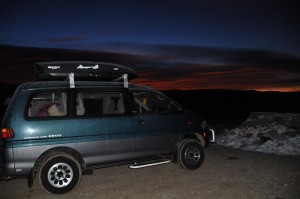
Following up on the stalling problem I mentioned ...
When I got home I drove the van into the shop and the next day I got underneath it and looked around. I found two locations where the fuel line leading to the injection pump had collapsed on itself, restricting the flow of WVO. Both restrictions occurred where the line curved to change directions. I did not think these bends were significant enough to do this, but obviously the combination of suction from the pump and the bend had collapsed the line. This leads me to wonder if I got the best fuel hose for a diesel … a thicker, stronger wall would help prevent this problem. Regardless, I re-routed and fixed the collapsed sections.
I also decided to clean the injectors while I had it in the shop. I had noticed more black smoke towards the end of the trip when starting and during quick accelerations … from what I had read fouled injectors (injector coking?) can contribute to this problem. (WARNING: there are little parts in the injectors … do this work over a clean workbench unless you want to be searching a dirty shop floor for these tiny parts … maybe I should just clean the shop floor?) From a visual inspection two of the fuel injectors were clean and two were fouled; I disassembled and cleaned all of the injectors (the Australian Delica website has an excellent PDF on doing this).
Happily, the van ran much better after this tune up; less smoke, better sound and no idle issue on WVO! Unhappily, after about another 500 km’s running on WVO the stalling on idle issue was back … this was not a happy moment. I put the van back in the shop expecting to find another collapsed hose … only there weren’t one. So, I pulled and cleaned the injectors again … one of the injectors did look fouled, the balance looked fine. I have gone from thinking that I had a fuel starvation issue to thinking that the WVO may not always be hot enough going into the injection pump. This initially surprised me as I have a heated filter and an in-line heater right before the pump. However, the heater is switched to shut off by a thermal sensor (attached to one of the injector feed lines) that shuts the heater off when the oil is hot enough. When I think about my stalling problem it seems to occur at cooler outside temperatures (below freezing temperature) after the van has been running for a while (hot engine, hot coolant). I am now wondering if the sensor is shutting the heater off too much in colder weather? Causing fouled injectors and leading to the stalling problems?
Not sure if I have correctly identified the problem, but again after cleaning the injectors the van is running fine on WVO … no stalling at idle. I have also disconnected the thermal sensor to see if this helps … we will see if I have solved this problem in another 500 km!
I was prepared to install an in-line fuel pump beside the WVO tank to push the oil to the injector pump (already purchased), but I have not done this yet as I am not convinced this is my problem given what I have found out.

 Call me BCDelica-less
Call me BCDelica-less